Compare Top 10 Service Orchestration Platforms: 1200+ reviews
Gartner predicts that by 2025, 80% of organizations will replace automation tools with service orchestration and automation platforms (SOAPs).1 These platforms orchestrate complex automation workflows and help implement business services that span multiple cloud environments. With their ability to manage automated processes, SOAPs reduce operational overhead and boost agility.
In this article, AIMultiple compares top service orchestration platforms based on B2B review scores and features.
| Service orchestration tool | The number of employees | The number of B2B review | B2B score |
|---|---|---|---|
| ActiveBatch | 379 | 251 | 4.6 |
| RunMyJobs by Redwood | 379 | 183 | 4.7 |
| Ansible | 19,775 | 211 | 4.5 |
| BMC Control-M | 9,776 | 150 | 4.6 |
| CA Automic Workload Automation | 4,599 | 14 | 4.4 |
| Fortra's Jams | 680 | 243 | 4.6 |
| HCL Workload Automation | 235,448 | 10 | 4.6 |
| OpCon by SMA Technologies | 143 | 34 | 4.1 |
| Stonebranch | 142 | 106 | 4.6 |
| Tidal Software | 379 | 50 | 4.8 |
The table above lists vendors in alphabetical order, except for the sponsors, who are listed at the top of the list.
Screening for top service orchestration platforms
Service orchestration coordinates and manages multiple interconnected services and systems to deliver complex IT and business processes. Some cloud orchestration platforms and workload automation tools have evolved to include service orchestration features, transforming into comprehensive service orchestration platforms (SOAPs). These platforms offer a range of capabilities, including workflow orchestration, resource provisioning, and hybrid infrastructure management.
Given these expanding capabilities, identifying the ideal platform for your digital business can be challenging. As SOAPs increasingly integrate with DevOps pipelines and support cloud-native infrastructure and application architectures, it’s crucial to choose a platform that aligns with your organization’s specific needs, flexibility, and interoperability.
To help you select the best service orchestration platform, AIMultiple has established a set of screening criteria to shortlist the top platforms in the market:
- Company size: We excluded companies with fewer than 100 employees. This helps focus on more established vendors with proven stability and resources to support ongoing development and customer service.
- B2B market presence: We included tools that scored 4 and above with at least 10 reviews across 5 B2B review platforms (G2, Trustradius, Gartner, Capterra, and PeerSpot). A strong market presence suggests a reliable and reputable service orchestration platform with broad adoption.
Based on these criteria, the top service orchestration platforms in the market are listed as follows:
ActiveBatch
ActiveBatch is an workload automation and job scheduling platform designed to automate end-to-end workflows across different environments. The platform offers a library of pre-built job steps which reduces the effort developers expend on researching, designing, coding, testing, and maintaining custom scripts. ActiveBatch also provides a drag-and-drop interface for workflow design, allowing IT teams to orchestrate tasks across applications, databases, and cloud services.
ActiveBatch connects disparate systems and applications through prebuilt integrations and a low-code Super REST API Adapter, which facilitates rapid development of API integrations for integrating with new technologies. Key functionalities include real-time monitoring, job dependencies, and SLA management, enabling efficient orchestration.
Explore more on ActiveBatch self-service portal for business users:
Analyze the offerings, pros & cons of ActiveBatch in-details.
RunMyJobs
RunMyJobs is a SaaS workload automation software that allows IT teams to automate and orchestrate business-critical processes. It supports the automation of diverse workloads across different systems, including on-premises and cloud-based environments.
RunMyJobs offers a centralized dashboard for managing automated processes, enabling IT teams to monitor and control job execution. It also provides prebuilt integrations and connectors to integrate with various applications and platforms, supporting complex automation workflows.
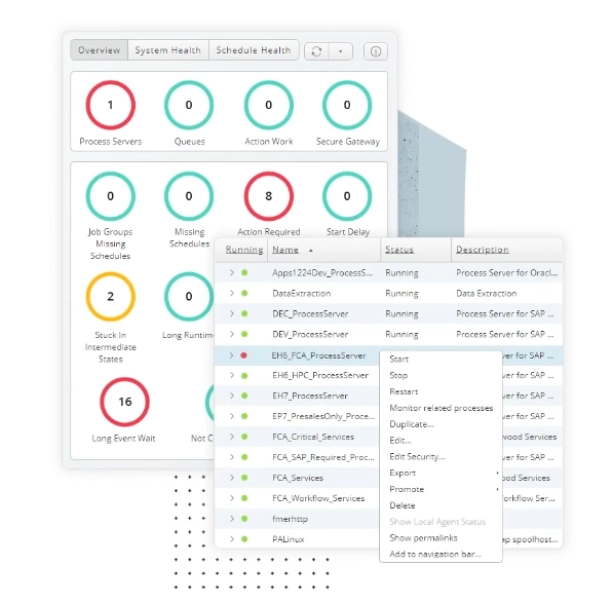
Learn more on the offerings, pros & cons of RunMyJobs in-details.
Ansible by Red Hat
Red Hat Ansible is an open-source IT automation platform designed to automate and orchestrate IT tasks across various environments. It uses a simple, human-readable language for defining automation scripts, allowing IT teams to automate configuration management, application deployment, and other tasks.
Ansible supports multi-platform orchestration, providing a flexible approach to automation. Key functionalities include agentless automation, modularity, and integration with cloud services and other applications, making it a versatile tool for service orchestration.
BMC Control-M
BMC Control-M is a workload automation platform that facilitates the orchestration and automation of IT processes across different environments. It provides a unified interface for scheduling and executing workflows, allowing IT teams to manage tasks across mainframe, distributed, and cloud platforms.
Control-M supports real-time monitoring, SLA management, and resource optimization, offering functionalities like dependency management and self-service automation. It is designed to improve operational efficiency and reduce manual intervention in IT workflows.
Explore Control-m alternatives considering their features, pros & cons evaluating B2B user reviews and scores.
CA Automic Automation
CA Automic Automation is an enterprise-grade workload automation platform designed to orchestrate and automate complex business processes across hybrid cloud and on-premises environments. It provides centralized workflow management and supports integration with various applications and platforms.
The platform offers real-time monitoring, event-driven automation, and automated job dependencies to facilitate efficient orchestration and SLA management.
Discover top Atomic competitors and other CA tools like AutoSys alternatives based on B2B review analysis.
Fortra’s Jams Scheduler
Fortra’s Jams Scheduler is an enterprise job scheduling and automation platform designed to automate IT workflows across various systems. It supports the orchestration of complex processes, enabling IT teams to automate tasks across different applications and cloud services.
Jams Scheduler provides a centralized interface for managing jobs, with features such as error handling, alerting, and reporting. It offers integration with third-party tools and APIs to create comprehensive automation workflows, improving operational efficiency.
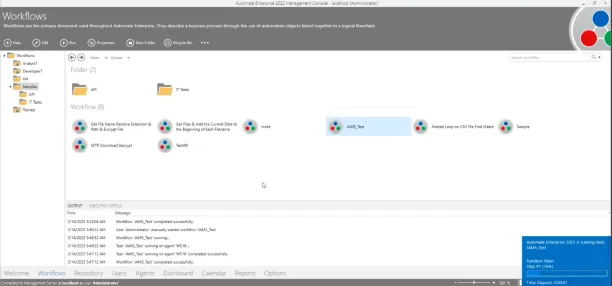
HCL Workload Automation
HCL Workload Automation is a service orchestration platform that optimize IT processes and enable job scheduling across complex environments.
HCL Workload Automation offers a centralized interface to coordinate various services, applications, and systems. By facilitating cross-platform interactions, it supports complex, multi-tiered IT architectures. It is a suitable choice for organizations seeking to automate and orchestrate their IT landscapes.
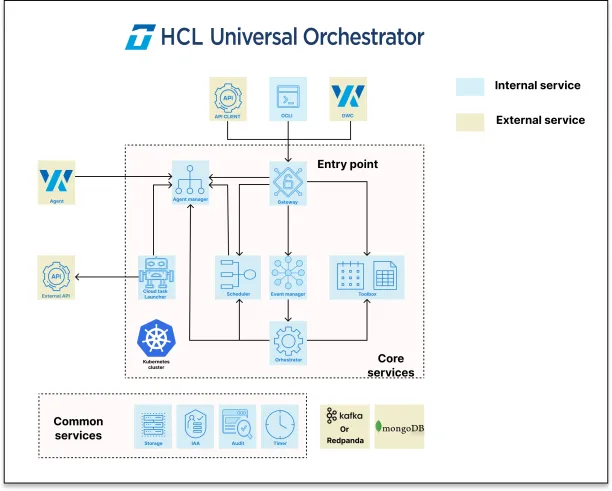
OpCon by SMA Technologies
OpCon is an enterprise workload automation tool designed to orchestrate and automate business-critical processes. It supports automation across on-premises and cloud-based environments, offering a centralized interface for workflow management.
OpCon provides robust automation capabilities, including event-driven workflows, cross-platform automation, and role-based access control. It is designed to improve operational efficiency and reduce manual tasks through comprehensive automation and orchestration.
Stonebranch
Stonebranch is a real-time IT orchestration and automation platform designed to automate business processes across hybrid and multi-cloud environments. It supports orchestration of workflows across different systems, offering a drag-and-drop interface for building automation workflows.
Stonebranch provides features like centralized monitoring, real-time job execution, and integration with third-party applications. It is designed to enable seamless orchestration of complex processes, reducing operational overhead and improving efficiency.
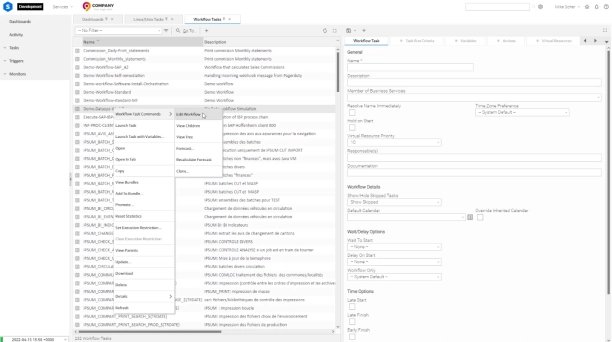
Explore Stonebranch alternatives based on features, pros & cons considering B2B user reviews and scores.
Tidal Software
Tidal Software is a workload automation and orchestration platform designed to automate business-critical processes across hybrid and multi-cloud environments. It provides a centralized interface for defining, scheduling, and monitoring workflows.
Tidal Software offers key functionalities like SLA management, cross-platform automation, and event-driven workflows, allowing IT teams to automate complex processes and improve operational efficiency. It also supports integration with various third-party applications, providing flexibility in creating automation workflows.
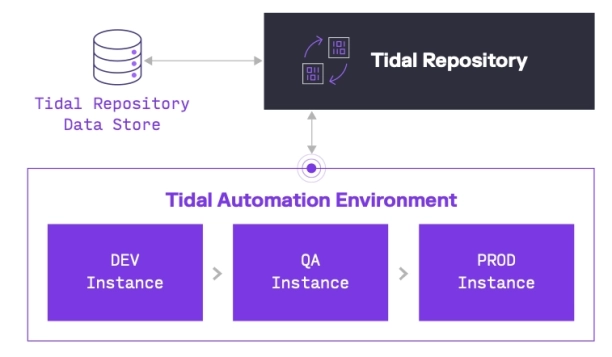
The 6 key capabilities of service orchestration platforms
Gartner identifies six key capabilities of Service Orchestration and Automation Platforms (SOAPs):
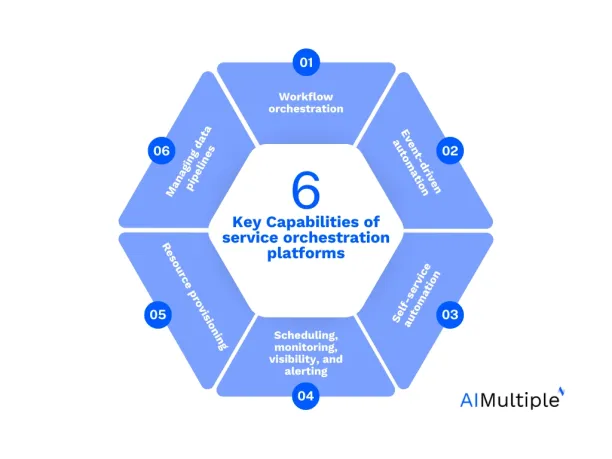
- Workflow orchestration: SOAPs offer a centralized, graphical interface to design and orchestrate workflows across various applications and platforms. This graphical flow design approach allows for visual representation of task interdependencies, enabling users to connect separate tasks and data with ease.
- Event-driven automation: This capability utilizes event-based triggers to enable organizations to move from traditional time-based scheduling to more responsive event-based automation. Automated workflows are initiated when specific events occur, providing greater control and reducing manual intervention.
- Self-service automation: SOAPs empower business users beyond the IT and Operations (I&O) teams to manage their own processes. Role-based access controls ensure security while allowing non-technical users to handle routine tasks. This shift enables IT teams to focus on strategic, higher-value projects.
- Scheduling, monitoring, visibility, and alerting: This capability provides real-time visibility into workloads, scheduled tasks, and services, along with alert mechanisms to notify users of issues. It helps improve service level agreements (SLAs) by offering a comprehensive view of operations across different platforms.
- Resource provisioning: SOAPs ensure that resources are appropriately provisioned and deprovisioned in cloud and hybrid environments without manual intervention. This automation optimizes resource allocation to meet current demand, reducing waste and increasing efficiency.
- Managing data pipelines: This capability focuses on the effective management of data flows, including the ingestion of multiple data streams and the automation of file transfers. SOAPs can programmatically create, schedule, and monitor these data pipelines, providing integration with other business tools for seamless operations.
Service orchestration platforms for Hybrid IT
IT automation stats show that 40% of all enterprise workloads are estimated to be deployed in cloud infrastructure, increasing demand for hybrid cloud automation and multi-cloud orchestration tools.
Service orchestration tools can deliver capabilities an organization’s hybrid digital infrastructure. These capabilities allow them to act like a cloud orchestration platform.
- Infrastructure as code allows to provision and manage cloud resources using machine-readable code, eliminating the need for manual setup or physical hardware configuration. This approach enhances automation, increases repeatability, and reduces the risk of human error during deployment and scaling operations.
- Container orchestration: With the widespread adoption of containerized applications for cloud-based services, service orchestration tools must support effective management and deployment of containers. This capability ensures efficient scaling, rapid deployment, and seamless operations for container-based workloads across hybrid and multi-cloud environments.
- Multi-cloud support:Given the variety of cloud platforms in use today, service orchestration tools must support multi-cloud environments. This includes efficient load balancing, scaling, and managing resources across public, private, and hybrid clouds. A reliable orchestration tool provides a unified interface to interact with different cloud platforms, offering flexibility and adaptability.
- Api automation: To streamline operations and manage complex workflows, service orchestration tools leverage automation through application programming interfaces (APIs). This feature allows automated configuration, integration, and control of various cloud services. It enables you to automate tasks, manage interconnected systems, and improve overall efficiency.
What is service orchestration and automation?
Service orchestration and automation is the process of integrating and managing various IT services and resources to coordinate different components of the IT environments, manage end-to-end IT operations and streamline business processes.
Service orchestration tools operate at the highest level of the IT infrastructure. This way, they facilitate IT teams to oversee processes, track resources, and connect distinct tasks into comprehensive end-to-end processes from a centralized control point, without depending on custom scripting.
Benefits of Service Orchestration
The benefits of service orchestration platforms are numerous and can have a significant impact on IT operations. Here’s a list with brief explanations:
1. Unified Management: Service orchestration platforms centralize the management of disparate processes and systems, allowing IT teams to oversee workflows across on-premises and cloud-based environments from a single tool.
2. Improved SLAs: By providing real-time monitoring and auto-remediation capabilities, service orchestration platforms can detect and address delays, overruns, or failures more efficiently. This enhances the ability to meet Service Level Agreements (SLAs), leading to improved response times and reduced downtime.
3. Rapid DevOps: These platforms support DevOps strategies by enabling seamless automation of Continuous Integration/Continuous Deployment (CI/CD) pipelines. Drag-and-drop workflow designers and reusable components make it easier to develop new services and end-to-end processes, speeding up DevOps cycles.
4. Operational Peace of Mind: With auto-remediation, monitoring, and timely alerting features, IT teams can address issues proactively. This reduces the time spent “fighting fires” and allows IT professionals to focus on strategic initiatives.
5. Greater Efficiency and Cost Savings: Universal connectors and API automation allow IT teams to automate more processes and reduce manual tasks. This efficiency leads to cost savings by minimizing idle resources and ensuring systems are decommissioned during periods of low utilization.
6. Consistency and Reliability: Orchestration ensures that tasks and workflows are executed in a logical flow, leading to consistent outcomes. This reduces the risk of performance issues or outages due to errors or misconfiguration.
7. Improved Collaboration: Service orchestration platforms can foster collaboration across multiple IT domains, such as network, security, and development, by providing a unified view of processes and workflows.
8. Quicker Application Deployment: With orchestration, applications can be deployed more quickly and efficiently, improving customer experiences and allowing organizations to stay competitive in the market.
Further reading
Explore more on other orchestration types and tools by checking out our comprehensive benchmarks:
- Analyze Best 10+ Container Orchestration Tools Based on 2000+ Reviews
- Compare 12 Data Orchestration Tools Based on 800+ Reviews
- Compare 18 Orchestration Tools: 5,000+ Reviews & Features
External sources
- 1. Saunderson, Betts & Ennaciri (January 23, 2023). “Market Guide for Service Orchestration and Automation Platforms.” Stonebranch. Accessed April 30, 2024.
- 2. “Proactive Workload Monitoring. ” RunMyJobs. Accessed at May 2, 2024.
- 3. “LOW CODE AUTOMATION. ” Jams scheduler. Accessed at May 2, 2024.
- 4. “HCL Universal Orchestrator architecture.”HCLTechSW. Accessed at May 2, 2024.
- 5. “Stonebranch Product Training.”Stonebranch Blog. Accessed at May 2, 2024.
- 6. “Tidal Repository.”Tidal Software. Accessed at May 3, 2024.

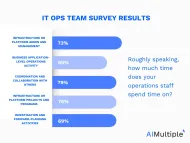

Comments
Your email address will not be published. All fields are required.